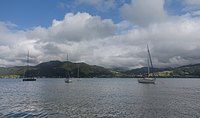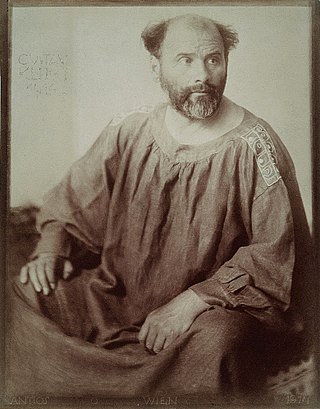
Gustav Klimt was an Austrian symbolist painter and one of the most prominent members of the Vienna Secession movement. Klimt is noted for his paintings, murals, sketches, and other objets d'art. Klimt's primary subject was the female body, and his works are marked by a frank eroticism. Amongst his figurative works, which include allegories and portraits, he painted landscapes. Among the artists of the Vienna Secession, Klimt was the most influenced by Japanese art and its methods.
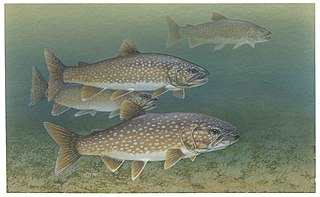
The lake trout is a freshwater char living mainly in lakes in northern North America. Other names for it include mackinaw, namaycush,lake char (or charr), touladi, togue, and grey trout. In Lake Superior, it can also be variously known as siscowet, paperbelly and lean. The lake trout is prized both as a game fish and as a food fish. Those caught with dark coloration may be called mud hens.

The Salzkammergut is a resort area in Austria, stretching from the city of Salzburg eastwards along the Alpine Foreland and the Northern Limestone Alps to the peaks of the Dachstein Mountains. The main river of the region is the Traun, a right tributary of the Danube.

Attersee am Attersee is a village on the western shore of Attersee lake in the Austrian state of Upper Austria.

Mondsee is a lake in the Upper Austrian part of the Salzkammergut and near the larger Attersee. Its southwestern shore marks the border between the states of Upper Austria and Salzburg and also between the Northern Limestone Alps in the south and the Sandstone zone of the northern Alps. The Drachenwand (Dragonwall) at the southern shore of the lake is an impressive sight. Mondsee is one of Austria's last privately owned lakes. In August 2008, owner Nicolette Wächter announced it was up for sale.

Mondsee is a town in the Vöcklabruck district in the Austrian state of Upper Austria located on the shore of the lake Mondsee. The town is home to the medieval Mondsee Abbey, whose cloister church was used for the site of the wedding in The Sound of Music.

The Arctic char or Arctic charr is a cold-water fish in the family Salmonidae, native to alpine lakes, as well as Arctic and subarctic coastal waters in the Holarctic.

Salvelinus is a genus of salmonid fish often called char or charr; some species are called "trout". Salvelinus is a member of the subfamily Salmoninae within the family Salmonidae. The genus has a northern circumpolar distribution, and most of its members are typically cold-water fish that primarily inhabit fresh waters. Many species also migrate to the sea.
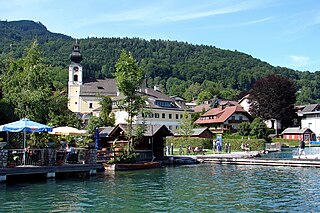
Unterach is a village in the Austria state of Upper Austria on the southern shore of lake Attersee in the centre of the Salzkammergut region.

Franz Karl Ginzkey was an Austro-Hungarian officer, poet and writer. His arguably most famous book Hatschi Bratschis Luftballon captivated generations of children.

Steinbach am Attersee is a municipality of the Vöcklabruck district in the Austrian state of Upper Austria. It is situated in the Hausruckviertel region on the eastern banks of the Attersee, part of the Salzkammergut area.

Prehistoric pile dwellings around the Alps are a series of prehistoric pile dwelling settlements in and around the Alps built from about 5000 to 500 BC on the edges of lakes, rivers or wetlands. In 2011, 111 sites located variously in Switzerland (56), Italy (19), Germany (18), France (11), Austria (5) and Slovenia (2) were added to the UNESCO World Heritage Site list. In Slovenia, these were the first World Heritage Sites to be listed for their cultural value.

The Mondsee group was a Neolithic Austrian pile-dwelling culture spanning the period from around the 4th millennium to 3rd millennium BCE, of particular interest due to its production of the characteristic "Mondsee copper", apparently the first in central Europe to emulate the Balkan Vinča culture.

Salvelinus umbla, also known as lake char, is a species of char found in certain lakes of the region of the Alps in Europe.

Salvelinus grayi, also called Gray's char[r], Lough Melvin char[r] or freshwater herring, is a species of lacustrine char in the family Salmonidae.

Insel im Attersee is a 1901-1902 landscape painting by the Austrian artist Gustav Klimt (1862-1918).
Irene Hellmann and Paul Hellmann were Jewish patrons of the arts from Austria whose legacy was erased in the Holocaust.

Lake Grundlsee is situated at the southern foot of the Totes Gebirge in Austria, in the Styrian part of the Salzkammergut. It lies at an altitude of 708 m above sea level. The municipal seat of Grundlsee is located on the northwest shore. The outflow of the Grundlsee is the Grundlsee Traun, which drains into the Danube via the Traun. With an area of 4.22 km2, Grundlsee is the largest lake in Styria. Its location, situated in a beautiful setting, has made it an important tourist destination and a popular bathing lake, as well as a diving and sailing area. The Daffodil Festival, Austria's largest flower festival, occurs every third year at Grundlsee. A professional fisherman manages the lake. The most prevalent fish species is the lake char, which is marketed as the Lake Aussee lake char.
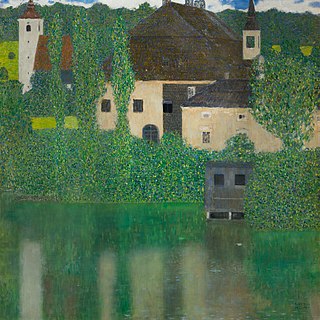
Schloss by the Water or Schloss Kammer on the Attersee I is a 1908 oil on canvas painting by Gustav Klimt now in the National Gallery Prague.




